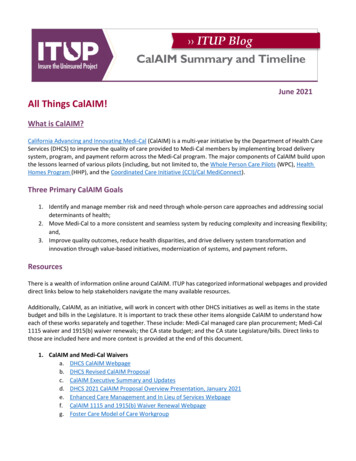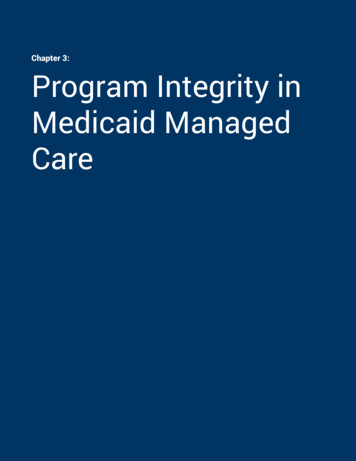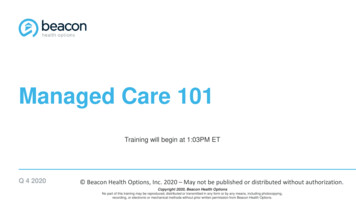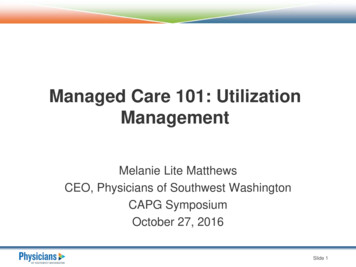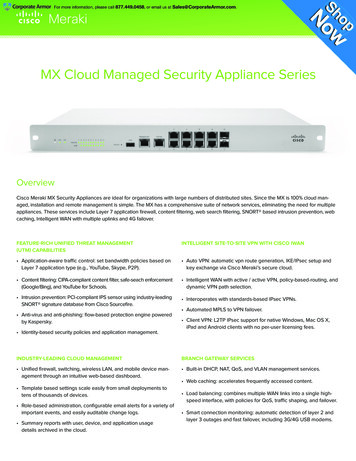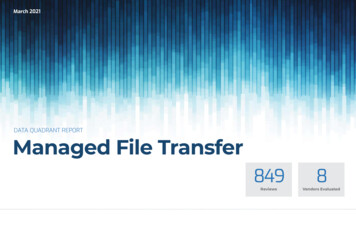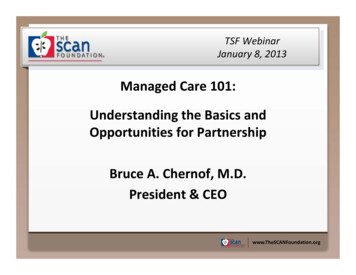
Transcription
TSF WebinarJanuary 8, 2013Managed Care 101:Understanding the Basics andOpportunities for PartnershipBruce A. Chernof, M.D.President & CEOwww.TheSCANFoundation.org
Presentation Overview: Managed Care 101 Background Goals and Components of Managed Care How it Works California’s Medi‐Cal Managed Care Infrastructure Integrating LTSS New Opportunities Building Partnershipswww.TheSCANFoundation.org
Background & History Early 20th century: “Prepaid health plans” LA‐DWP, Kaiser 1960’s: Calls for health maintenance organizations 1973 HMO Act: Created organized health systems 1974 ERISA: Protect employer‐sponsored health coveragefrom malpractice suits Late 1980’s & 1990’s: Dramatic HMO growth Late 1990’s & 2000’s: Public backlash against restrictions 2013: Nearly all working individuals with coverage areinsured through some managed care formwww.TheSCANFoundation.org
Goals of Managed Care Control costs– Health care costs growing faster than GDP– Reduce inappropriate use of services– Increase competition Improve quality Improve population health Increase preventive serviceswww.TheSCANFoundation.org
Managed Care Components Network: Selective contracting with providers Medical Home: Primary care gatekeeping function Prior Authorization/Pre‐certification: Oversight ofspecialty visits/elective procedures Benefits Package: Defined set of covered services Formulary: Rationalized and/or tiered pharmaceutical list Utilization Review/Management: Managing in‐patientadmission and length of staywww.TheSCANFoundation.org
How it Works: Product Types Health Maintenance Organization (HMO) Centered on primary care provider as the “organizer” All non‐emergent care requires prior approval(other than primary care) Preferred Provider Organization (PPO) Member selects provider of choice Initial PCP visit/ specialty prior auth not required Point of Service (POS) At time of need, member selects HMO or PPO pathwaywww.TheSCANFoundation.org
How it Works: HMO Models Staff model – doctors, hospitals, otherservices all in same organization– Veterans Health System Network model – health plan arranges carethrough separate contracts with hospitals,physicians, other providers– Most common model in California– Blue Cross, Blue Shield, Health Net, and Local Initiativeswww.TheSCANFoundation.org
How it Works: Capitation Fixed fee (per member per month)Specific period of time (generally a month)Defined set of services (benefits)Assigned population of membersProvider accepts “risk” for delivering serviceswww.TheSCANFoundation.org
How it Works: Provider Payment Types Capitation (physician groups, hospitals)– With/without shared risk/savings arrangement Negotiated fee for service (some physicians,ancillary services, labs, radiology) Per diem fixed daily payment (hospital, SNF) Per episode of care– Now: transplants, DRG’s– Future: acute/post‐acute bundled paymentswww.TheSCANFoundation.org
How it Works: Provision of Services1. Is service or product a benefit?2. Is it medically necessary?3. Has it been authorized, if auth required?4. Is it a network provider?www.TheSCANFoundation.org
How it Works: Organizing Physicians Medical Group – doctors as employees Independent Practice Association (IPA)– Doctors own/operate private practices– Serves as contracting vehicle Provide critical mass of PCPs & full specialty network Cover a broad enough geography– Serves as management vehicle Business functions (e.g., capitation reconciliation) Clinical functions (i.e., UM, prior‐auth)www.TheSCANFoundation.org
Current Models of Managed Care1. Medicare Special Needs Plans (SNPs)2. Duals Integration Pilots3. Managed LTSS4. Accountable Care Organizations5. Medical Home Pilots6. Independence At Home Pilot (house calls)7. Bundled Payment Pilotswww.TheSCANFoundation.org
California’s Medi‐Cal Managed Care Systemwww.TheSCANFoundation.org
Medi‐Cal Managed Care Models Two Plan Model: State contracts with 2 plans: a local initiative(locally developed and operated), and a commercial plan.– Available in 14 counties, serving 3 million beneficiaries County Organized Health System: One health plan administeredby a public agency and governed by an independent board.– 6 health plans available in 14 counties, serving 850,000beneficiaries Geographic Managed Care: State contracts with severalcommercial plans in a county– Available in 2 counties, serving 450,000 beneficiarieswww.TheSCANFoundation.org
California’sMedi-CalManaged CareCountieswww.TheSCANFoundation.org
Managed Care:Integrating Long‐Term Services and Supports(LTSS)www.TheSCANFoundation.org
New Opportunities:Integrating LTSS in Managed CarePrimary goal: Develop a person‐centeredsystem of care that addresses range ofindividual needs by: Increasing access to HCBS Safely decreasing institutional utilization Improving clinical and quality outcomes Building on consumer choicewww.TheSCANFoundation.org
Potential Partners for HCBS Providers Health Plans Hospitals / Health Systems Medical Groups / IPA’s Medicare Advantage Plans Special Needs Plans Accountable Care Organizationswww.TheSCANFoundation.org
Opportunities for HCBS Providers Care transitions post‐hospitalization orrehabilitation stay Preventing inappropriate 30‐day hospitalreadmissions HCBS support for those with high risk / highutilization patterns Others www.TheSCANFoundation.org
Building Partnerships with Managed Carewww.TheSCANFoundation.org
Develop a Business Case, Must Demonstrate1. Economic burden if nothing is done2. Your services can alleviate some of that burden3. Economic value of your services expenseshealth partner will incur to pay for them4. By you delivering the services, you create morebenefit than competitors or health plan creatingservice themselvesSOURCE: Tabbush, Victor. Overview of Preparing Community‐Based Organizations for Successful Health Care Partnerships. 2012 .www.TheSCANFoundation.org
Key Leadership Competencies Strategic orientation Achievement and performance Innovative thinking Change management Building effective teams Communication Negotiation Relationship building and maintenance Analytical, data‐driven decision‐makingSOURCE: Tabbush, Victor. Overview of Preparing Community‐Based Organizations for Successful Health Care Partnerships. 2012 .www.TheSCANFoundation.org
Key Management Competencies Planning and project management Marketing Promoting services and making the business case Financial acumen Cost accounting and fee setting Assembling, managing, & coordinating resources Information systems Monitoring and evaluation systemsSOURCE: Tabbush, Victor. Overview of Preparing Community‐Based Organizations for Successful Health Care Partnerships. 2012 .www.TheSCANFoundation.org
Reactor PanelLydia MissaelidesCA Association for Adult Day ServicesCarol RaphaelVisiting Nurses Association of New YorkAbbie TottenCA Association of Health Planswww.TheSCANFoundation.org
Our mission is to advancethe development of asustainable continuum ofquality care for seniors.Our vision is a societywhere seniors receivemedical treatment andhuman services that areintegrated in the settingmost appropriate to thetheir needs and with thegreatest likelihood of ahealthy, independent life.Sign up to receive email alertsatwww.TheSCANFoundation.orgFollow us on Twitter@TheSCANFndtnFind us on FacebookThe SCAN Foundationwww.TheSCANFoundation.org
www.TheSCANFoundation.org TSF Webinar January 8, 2013 Managed Care 101: Understanding the Basics and Oppo
